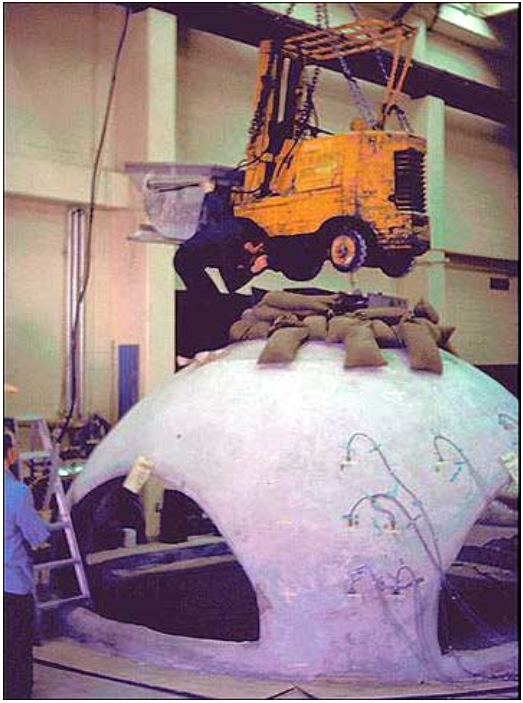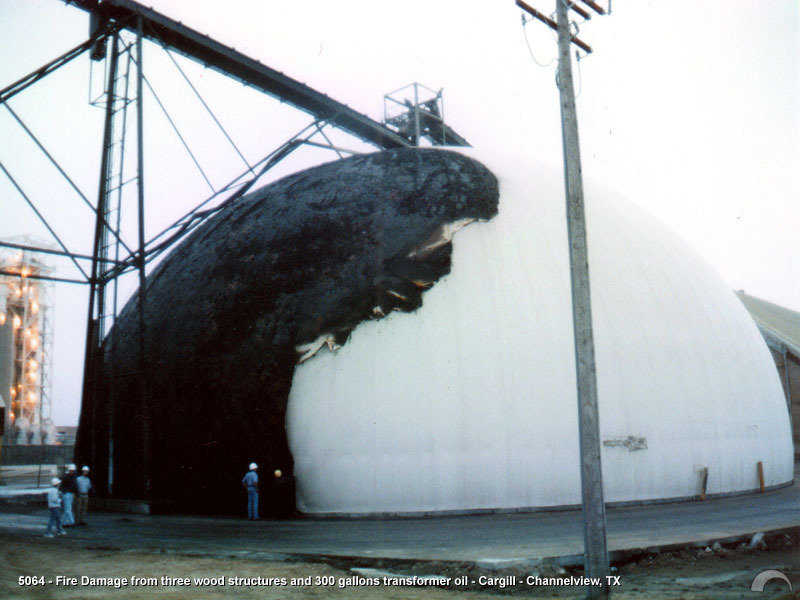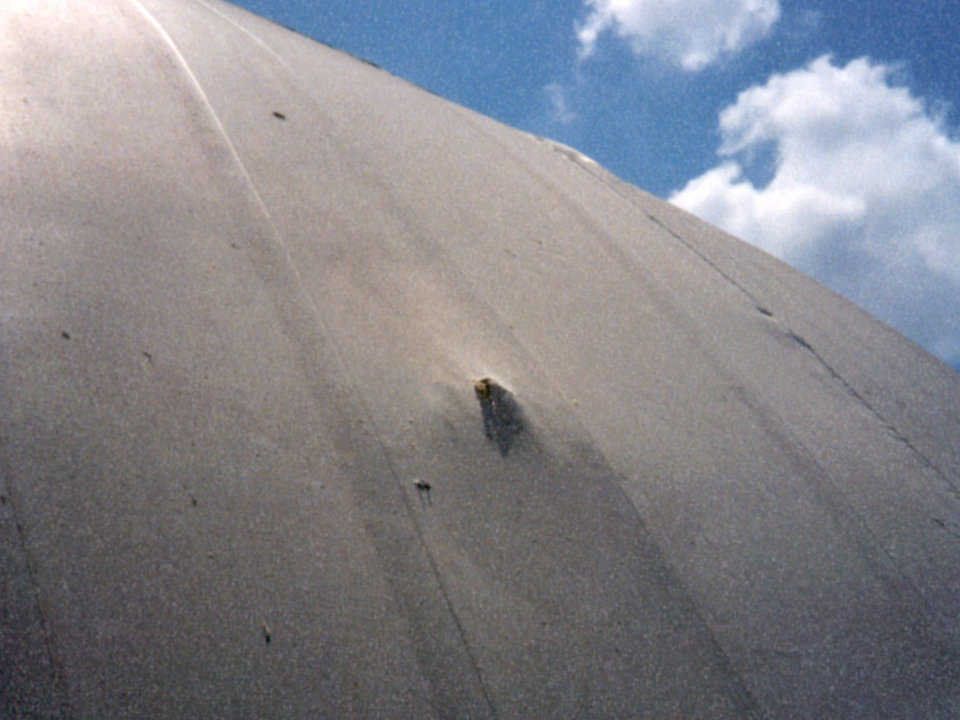
Strength testing the Monolithic Dome at BYU Laboratories. The sand bags represent the amount of weight previously thought to be the maximum load this dome could take. The addition of the forklift did nothing. They were ultimately unable to break the shell by overloading it and had to take it apart with jackhammers.
Monolithic Domes Have Blast-Resistant Strength
Monolithic Domes can withstand terrorist attacks better than most conventional buildings.
Thin shell concrete structures stand up to allied bombing
In 1976 I hired a German engineer for a dome project in Germany. Although I never asked for it, he sent me a report stating that, during World War II, thin shell concrete buildings in Germany faired far better than other structures.
He further reported that during bombing incidents – if thin shells took a direct hit – either the bombs ricocheted off the structures and exploded away from the buildings, or they penetrated the shell and went off inside.
In either case, the bombs did not bring the buildings down. If the explosive created a hole in the shell, patching the damage was not difficult and cleanup and remodeling could be safely done inside.
This report intrigued me. It came at a time when my brothers and I first started building and promoting Monolithic Domes. Further checking with our thin shell engineer revealed that a three-inch-thick, concrete thin shell could withstand more of a bomb blast than a twelve-inch-thick, highly reinforced, concrete straight wall.
The Monolithic Dome
The Monolithic Dome is a concrete thin shell with a three-inch layer of urethane foam covered by a fabric on its exterior.
For further protection, another layer of reinforced concrete can be easily applied over the exterior fabric. This additional layer not only protects the fabric, but provides armor plating for the already blast-resistant Monolithic Dome.
Obviously, our modern-day thin shell – the Monolithic Dome – can be constructed to be even stronger, tougher and more resistant to attack than the thin shells of the past.
Monolithic Domes and bombs
In the early 1990s, Monolithic built 28 domes in Iraq, while it was at war with Iran. Twenty-seven of the domes were grain storages, 117’ in diameter and 58’ tall. In addition, a 117’ dome was built as a mosque for Saddam Hussein.
That mosque was bombed by a 5000 pound bomb during the more war in Iraq. Although the interior will need massive repair, the dome itself is structurally sound. Photos of the mosque after the bombing were displayed in the August 2003 issue of Government Executive in an article titled “Remaking Iraq.”
In March 2009, Monolithic also received an interesting email. Kevin wrote,“I am an army helicopter pilot currently serving in Iraq and there is primarily concrete construction in the area. There are only a few domes that are mostly part of mosques and such but this one in particular is in the middle of an old Iraqi military compound that we now use as a helicopter gunnery range. It is definitely a concrete dome with rebar reinforcement like your own and we had teams shooting rockets at it for months before someone finally was able to punch a hole in it. Even direct hits would often glance off of it, it was pretty impressive.”
Monolithic Domes and surviving terrorist attacks
Terrorist bombing attacks are most often directed against people inside a building. Such attacks often include blowing up a truck parked in front of a building or ramming into structures and detonating explosives. The Monolithic Dome can better withstand these types of attacks than almost any other type of building.
An engineer can demonstrate that any kind of pressure against a dome rapidly dissipates around a curve. But pressure against a flat surface concentrates in the center. This physical principle is one of the reasons why domes are far superior in surviving a blast.
Biological Containment
Biological containment by a Monolithic Dome is inherent. Because they are airtight structures, Monolithic Domes offer major protection from gas, radiation and bio-hazards. This is especially important for schools, military command centers and other large capacity buildings.
Withstanding small arms and direct fire weapons
Monolithic Domes can protect occupants from most indirect fire weapons, as well as small arms fire and many other direct fire weapons. We have tested this on our own buildings.
This protection capability of the Monolithic Dome can be further enhanced by covering the Airform with concrete. The concrete-foam-concrete sandwich is the best protection against weapons fire.
Monolithic Domes outlast rampant fires
The Monolithic Dome is as fire-safe as a building can be made. Only what is carried into the structure can burn. Much of the damage done to cities during World War II was caused by fires which were seeded by bombs and grenades. These fires would not have compromised the security of the Monolithic Dome.
Military Applications
A quick study of Monolithic Domes shows that they are the logical buildings for most military applications. Their cost of construction is reasonable. They require less materials to construct and are generally faster to build than conventional buildings. Energy reduction is usually 50% or more. They are permanent. And they are easy to lock down and defend. Hostile entities would find it very difficult to break through a Monolithic Dome.
More importantly, Monolithic Domes can withstand natural and manmade disasters. They are blast-resistant. They make excellent munition storages, reducing the risk of detonating the contents by hostile fire. If the contents DO detonate, the Monolithic Dome can protect the surrounding area from the explosion.
The government invests billions of dollars in military and research equipment. It would make good financial sense for these tanks, planes, automobiles and even the space shuttle to be stored in Monolithic Domes instead of metal tents.
The Monolithic Dome is the only building that can be built at a reasonable price to meet FEMA’s guidelines for a building that provides near-absolute protection.
Related Links:

This damage was caused by a huge explosion of 300 gallons of transformer oil. The oil burned for nearly an hour with winds of up to fifty miles per hour blowing it directly against the dome. The two wood buildings that were attached to the dome were completely incinerated.
This happened in the middle of the night. Fire crews didn’t appear on the scene until after the fire had burned itself out.
The contents inside the dome were completely unharmed. The ambient and wall temperatures only rose a tiny amount. Fire damage to the dome was cosmetic. (1996)

This is all the damage that was caused by a 30.06 Rifle firing a fully jacketed bullet at close range. The bullet did NOT penetrate the building.
A 30.06 rifle with a fully jacketed bullet easily slices through a bullet-proof vest or several layers of concrete blocks.